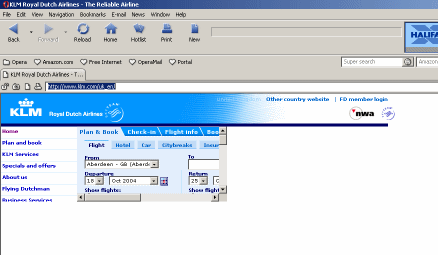lecture menu
lecture 6: diversity
HTML has gone through various stages of evolution, but has always been a standard that can be interpreted differently depending on what you actually want to do with it. The manufacturers of different browsers have always had an interest in tweaking with the standard, because this was a way they might have gained a small edge over the competition and/or sell related products (e.g. it clearly makes commercial sense for Microsoft's design tool, Front Page, to write sites that look best in Internet Explorer rather than other browsers).
Unfortunately, what has arisen is a situation where the inbuilt flexibility of HTML has been damaged. The message below, or versions of it, are distressingly common online:

...which in this case compounds the problem by selecting a basically obsolete browser.
Worse still are the many sites - some belonging to extremely rich and large corporations - which simply do not work at all in some browsers. Below is a screen shot of KLM's web site as viewed in Opera 6.05. I note it terms itself "The Reliable Airline", but Opera users may never know seeing as this page is impossible to use in that browser for its intended purpose. It's not just that the screen is unnaturally restricted; none of the links in the main menu on the left work at all! You might also like to look at this article from The Register which names many more "villains" in this regard, although it should be noted that the article is a couple of years old now (for instance, Smile have finally updated their site to work in Opera).

I find it rather breathtaking that this kind of thing is not considered a problem by "professional" designers and their clients. An argument is sometimes made that it will cost more money to make sites compatible with many browsers and this is somehow going to make companies "uncompetitive". But, we are always told we live in a free-market democracy, and one of the supposed pillars of that is personal choice. Am I barred from driving on certain roads because I have the wrong make of car? Can you prevent me from walking down a particular street because I am wearing the wrong brand of clothes? That is what we are talking about here. In summer 2004 there were significant worries about Internet Explorer's vulnerability to viruses and other forms of malicious computer code concealed on web pages, and a resultant increase in the use of so-called "minority" browsers as an alternative. If web sites cannot accommodate the users of these browsers that can only do harm to both the reputation and the market share of any business or organisation.
More fundamentally, we should remember that the WWW is a young medium, and still evolving. One reason for the release of XHTML 1.0 was that this was a standard designed to cope with as-yet-unforeseen future interfaces, such as future generations of mobile phones. And nothing said so far deals with the issue of specialist browsers such as those used by the blind. The XHTML standard exists for a reason! The closer that web sites conform to it, the more likely it is that they will be accessible to all, and not just now but in the future as well. They will not have to be rewritten every time some new browsing tool comes out, thus making them more cost-effective (and giving the lie to the earlier argument about "uncompetitiveness"). More on all this in the next few slides.
